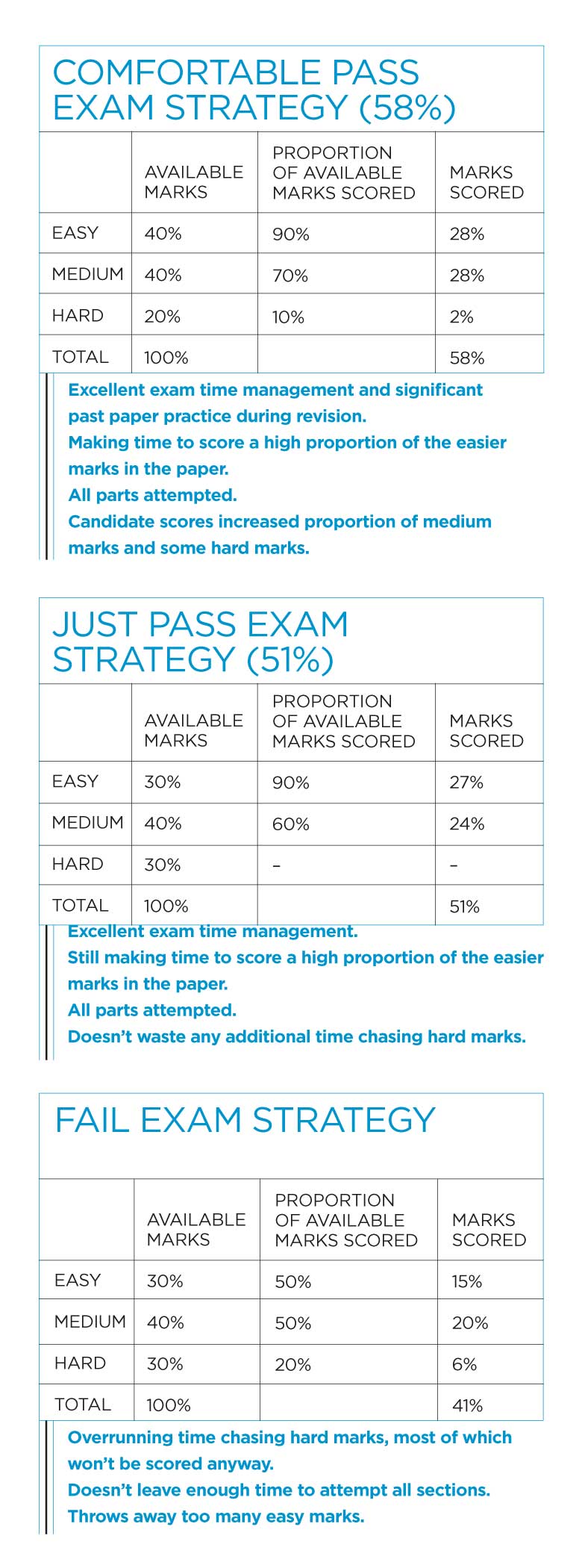Your scarcest resource during your ACT exam will normally be time, not knowledge. Nearly all candidates have sufficient knowledge to pass their exam. The key difference between successful candidates and others is the quality of their time management. You will need excellent time management during your exam. You will also need excellent time management during your revision. 
Successful candidates manage their exam time so they have time to attempt all questions, all parts of all questions and all sub-parts of all questions. They also manage their revision time to hone their exam technique; they practise past exam papers repeatedly against the clock. The most common failing among unsuccessful candidates is poor time management during the exam. They overrun time on difficult questions or sections, or questions they have fallen in love with, and miss out on scoring easy marks elsewhere in the paper. And they have rarely done enough past exam paper practice during their revision.
Don’t neglect to read your examiners’ reports early and often as part of your exam preparation
Before the exam, your most valuable resource is your study time. If you increase your study hours, you will hugely increase your prospects of exam success. So ensure you maximise your study hours and make best use of them. This is simple, but not easy, because there are a number of other legitimate calls on your time. Block out the study hours anyway. That way you will save yourself all the study hours and other additional costs of a future resit.
Start off by booking study leave away from work. If you’ve already booked leave, book some more. Then write ‘Day 0 – Pass exam’ into your diary on your exam date. If your exam is on 3 October, and today is 1 September, it is now Day 32. Write all the days between today and your exam day as a countdown in your diary. You need a reminder that will press you to focus on your exam preparations. The increasing sense of urgency as the days pass will also reassure you that it is time to get on with your essential past paper practice, rather than less important study tasks. Don’t neglect to read your examiners’ reports early and often as part of your exam preparation. All your examiners want you to pass their exam so they have written in detail about how to pass their particular exam. Do read their good advice, and follow it. You need to practise your exam technique repeatedly against the clock to ensure you will perform well under pressure on the day. Many study topics can be summarised in a small number of key diagrams. So identify your key diagrams, then practise reproducing them daily. In general, the best way to make use of your study hours is to answer full past exam questions and full past exam papers under exam conditions. Mark your own answers using the published solutions and read the helpful and detailed examiners’ reports, ensuring you understand them.
The first marks you will score on any question or part-question are normally the easiest. So long as you have enough exam time to attempt every question and every part-question, you are almost certain to score those first available easy marks. Meanwhile, the way to make sure you always have enough time, is to avoid any time overruns elsewhere. By writing your intermediate finish time by every question, and every part-question, you will give yourself the earliest and most effective warning of any potential time overrun. Having made your time plan, stick to it. As soon as you reach the end of your allocated time for each part-question, move on ruthlessly. Many exam requirements contain two or more tasks. You need to identify, and then answer, every separate task. If you are asked to calculate an answer, and then comment on your result, you need to make a comment or you will throw away easy marks. Diagrams and tabulation will usually show your understanding far more efficiently and effectively than text. Prizewinning scripts are often peppered with diagrams. The more diagrams and tables that you set out in your script, the fewer words you will need to write, and the more valuable exam time you will save. And finally, well-spaced-out work is easier to read and easier to credit than work that is cramped. Stay out of the margins, and out of the last few lines of each page. Consider writing on alternate lines.
 The CertITM and CertITM-PF exams are fully multiple-choice exams and are marked differently from all the other ACT exams. In the CertITM and CertITM-PF exams, you will receive an exam paper that consists of 100 multiple-choice questions, a formula sheet, paper for workings and an answer sheet for completion. For CertITM and CertITM-PF only, candidates’ workings are not taken into consideration in marking. In all other exams, workings are taken into consideration in marking.
The CertITM and CertITM-PF exams are fully multiple-choice exams and are marked differently from all the other ACT exams. In the CertITM and CertITM-PF exams, you will receive an exam paper that consists of 100 multiple-choice questions, a formula sheet, paper for workings and an answer sheet for completion. For CertITM and CertITM-PF only, candidates’ workings are not taken into consideration in marking. In all other exams, workings are taken into consideration in marking.